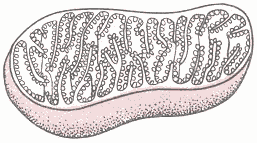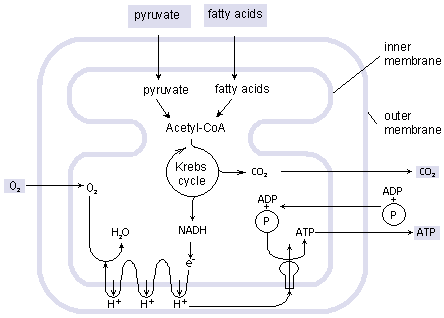Russian
MITOCHONDRIA
 Mitochondrion (Greek: mitos - "thread", chondrios - "grain") is the main spot of
aerobic respiration activity of the
cell. The number of mitochondria in a cell is not constant. It depends on the species of an organism and the nature of a cell. A cell with strong need in energy (for example, a liver cell) can contain up to a thousand of mitochondria. Mitochondria can be spiral, round, rod-shaped, cup-shaped, even branched. The length of mitochondria may vary from 1.5 to 10.0 microns, diameter from 0.25 to 1.00 micron.
Mitochondrion (Greek: mitos - "thread", chondrios - "grain") is the main spot of
aerobic respiration activity of the
cell. The number of mitochondria in a cell is not constant. It depends on the species of an organism and the nature of a cell. A cell with strong need in energy (for example, a liver cell) can contain up to a thousand of mitochondria. Mitochondria can be spiral, round, rod-shaped, cup-shaped, even branched. The length of mitochondria may vary from 1.5 to 10.0 microns, diameter from 0.25 to 1.00 micron.
Mitochondrion has a double
membrane dividing it into two
compartments. The area limited by the inner membrane thrown into folds (the folds are called
cristae) is known as
mitochondrial matrix. It contains
ribosomes and
mitochondrial DNA, circular double-stranded molecule encoding some of mitochondrial proteins. Cristae in the inner membrane significantly increase its surface, thus, providing the site for placing multi-enzymatic systems and facilitating the access to the
enzymes in the mitochondrial matrix.
The compartment between the outer and inner membranes, which is called
intermembrane space, contains
substrates, enzymes and some
metabolites.

Mitochondrion is the main site of
ATP synthesis in animals. The most part of
oxidizing cell processes is accomplished in mitochondria. Mitochondria resemble bacteria in shape and size. They contain
DNA and replicate. It is thought that
eukaryotic cells are descendants of primitive
anaerobic organisms who survived in the world rich in oxygen having devoured aerobic bacteria. Instead of digesting the bacteria, these organisms fed them and kept in symbiosis for the sake of their ability to use atmospheric oxygen and produce energy.
Supplementary information
|
 Mitochondrion (Greek: mitos - "thread", chondrios - "grain") is the main spot of
aerobic respiration activity of the
cell. The number of mitochondria in a cell is not constant. It depends on the species of an organism and the nature of a cell. A cell with strong need in energy (for example, a liver cell) can contain up to a thousand of mitochondria. Mitochondria can be spiral, round, rod-shaped, cup-shaped, even branched. The length of mitochondria may vary from 1.5 to 10.0 microns, diameter from 0.25 to 1.00 micron.
Mitochondrion (Greek: mitos - "thread", chondrios - "grain") is the main spot of
aerobic respiration activity of the
cell. The number of mitochondria in a cell is not constant. It depends on the species of an organism and the nature of a cell. A cell with strong need in energy (for example, a liver cell) can contain up to a thousand of mitochondria. Mitochondria can be spiral, round, rod-shaped, cup-shaped, even branched. The length of mitochondria may vary from 1.5 to 10.0 microns, diameter from 0.25 to 1.00 micron.
